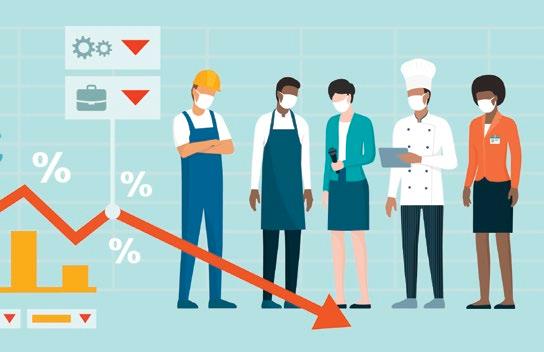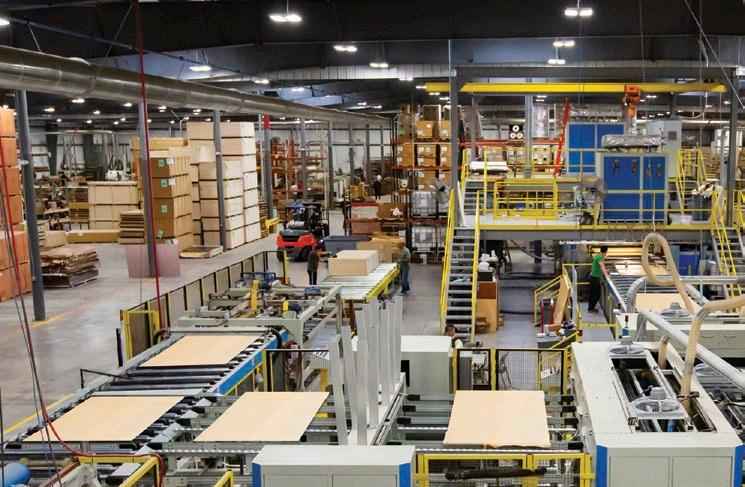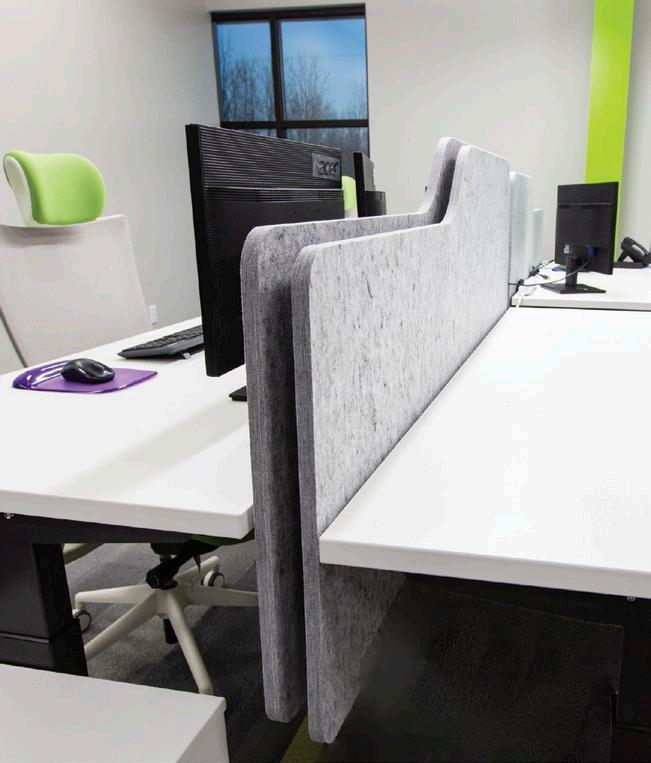
7 minute read
COVID-19 in the Workplace: Where We Are Now
ABY PAIGE M c ALLISTER s the pandemic continues and businesses reopen under restrictions which vary by city, county and state, Affinity HR Group continues to monitor several topics and issues to help our clients through these confusing times. Below are some of the current topics we are seeing.
EMPLOYER COVID LIABILITY: Employees being in the workplace increases their exposure to COVID-19 which means they may be able to make an unsafe workplace claim or a claim against your Workers’ Comp policy, for example. To help mitigate some of that liability, take all possible safety measures to reduce the employees’ risk of exposure.
While some states have passed legislation to help protect employers, this legislation will not provide blanket immunity as companies must comply with certain criteria such as following COVID-19 safety precautions for coverage.
Some companies are requiring employees to sign liability waivers, but these do little to reduce legal exposure if challenged. Conversely, it may indicate to employees that you lack confidence in your safety measures which may make employees more concerned about coming to work.
MASK MANDATES: If you have a mask-wearing mandate for employees and visitors, whether due to state regulations or company safety practices, enforce those requirements consistently for the health and safety of your employees and customers. Also, give your employees the support when refusing to deal with a customer without a mask.
VACATION/PAID TIME OFF: Some employees may want to start using their paid time off (PTO), requiring you to ensure you have control of several aspects.
Confirm your policies allow you to control who is taking time (usually through an approval process) to ensure proper coverage at all times. Do not use only first-come, first-served or seniority as reasons for approval; include reason for time off as some employees will need time off for critical events such as weddings, funerals, and taking their child to college.
Consider implementing temporary carryover or payout policies so employees do not have to choose between taking unwanted time off and losing their benefits.
We recommend not requiring employees to exhaust all of their PTO, especially if all of the FFCRA time has been exhausted, so they have time available if they become sick later in the year.

TRAVEL: As states reopen, employees may begin to travel, increasing their chance of exposure. Traveling may necessitate the employee to self-quarantine and/or get tested. If an employee is planning to travel, discuss the repercussions such as use of PTO, quarantine period, testing, etc., prior to departure so they know the expectations before they leave.
If traveling for work, consider the true need or value of the travel and postpone if possible. You will need to pay their regular wages for any quarantine time, and, if they are exposed, it will most likely fall under your Workers’ Comp.
If traveling for vacation, decide ahead of time if you will require the employee to stay away from the office, to get tested, and, if/how all this time will be paid.
CONTINUED ON PAGE 26 › While some states have passed legislation to help protect employers, this legislation will not provide blanket immunity as companies must comply with certain criteria such as following COVID-19 safety precautions for coverage.

BACK-TO-SCHOOL/SUMMER CAMP: Employees may not have child care options if summer camp or child care is not available, and this may not improve if schools cannot reopen full-time in the fall. Communicate with employees to create a plan of action such as intermittent schedules, shorter days, or working weekends.
For employees who have time available, FFCRA/extended FMLA continues for up to 12 weeks but, if the closed child care provider changes (i.e., school to summer camp to school), require the employee to submit a new FFCRA request form with documentation of that closure.
SCREENING/TESTING: There are several options for screening and/or testing employees before returning to work and/or before each shift.
Screening: A brief questionnaire and/or taking of their temperature, usually before each shift, assesses the employee’s health each day by monitoring for the common symptoms of COVID-19. Anyone who has concerning symptoms can be sent home until further determination can be made. Screening is non-invasive and needs to be done consistently, but it will not reveal employees who may be asymptomatic and positive.
COVID-19 Testing: A nose-swab test for active COVID virus is usually done if the employee is showing symptoms or after possible exposure. Since some areas are struggling to meet demand, employees may not be able to get a test without a qualifying reason; if they do, it could take several days to get the results. Testing only tests the presence of the virus at a point-in-time, and a negative result does not mean the employee will not get it in the future. Testing can only be required if there is a risk of transmission to other people.

COVID-19 Antibody Test: A blood test to determine if there are antibodies showing previous infection. Not all tests are reliable, and a positive result does not mean they will not get it again in the future. This test cannot be required as it violates ADA.
OUR RECOMMENDATIONS:
Allow anyone who can to work from home for as long as possible to reduce chance of exposure in your office and to keep work flowing as there would be a much smaller chance of employees getting sick and being out for several days or weeks.
Require and enforce consistent safety protocols: screening, social distancing, face masks, no large groups, no small, closed spaces, hand sanitizer, and hand washing, etc.
Require employees to speak up immediately if they are not feeling well. Review the symptoms and procedures for possible illness and exposure and send home if there is a question.
Paid time off and extended FMLA under FFCRA is still applicable. Offer it to anyone who needs it that has time remaining. s&p

Q.
As a result of the ongoing COVID-19 pandemic, our business model has changed. The service that was our primary source of income has not been needed so we had furloughed most of our employees. However, demand for our secondary or new service has exploded. Unfortunately, most of the furloughed employees do not have the skills and experience to provide this secondary or new service, and we need help now. Can we hire a new employee while other employees are still furloughed?
A. Yes, probably. In most employment-at-will situations, you are able to employ the best person for the job you need done. This means that, if currently-furloughed employees do not have the skills or talents to effectively perform the job duties you need, you should be able to hire a new employee. It is essential to hire someone who has different abilities, education, or experience than anyone currently in your workforce that enable them to perform that service when and how you need it.
There may be more restrictions to your ability to hire a new employee if you have employees under a CBA (labor contract) or depending on how you worded the furlough notice.
As always, document your decisions and procedures to be able to show that you hired the new employee based on the services they could provide rather than to replace a furloughed employee for a discriminatory reason. n
PAIGE McALLISTER, SPHR Affinity HR Group contact@affinityhrgroup.com
Laminat Panel ion
Engineered for the high-performance workplace
Genesis has the capacity, quality and customer commitment to act as a seamless extension of your team. With world-class manufacturing technologies and 100% domestic production, we’re ready to ramp up and invest in a long term supplier partnership.

Seamless outsourcing for office & residential furniture components
Laminated Panels
Panel Processing
Wrapped Mouldings
Cabinet Doors
Thermofoil Components
Drawer Boxes & Rails
Table & Counter Tops
Call for OEM program pricing for PET Panels 877-266-8292

Screens Privacy
Enhance the workplace environments and return to work safely

Standard issue cubicles are outdated and uninspiring. Our PET office partitions and privacy screens take aesthetics and performance to the next level, with details that make a difference in the modern workplace.
Environmentally friendly
Contains recycled plastic bottles and materials
Extensive finish options
Modern fabrics, dry-erase and decorative laminate surfaces
Enhanced acoustics
PET non-woven screens provide superior sound absorption.
Customized solutions
Manufactured to your spec in thickness, size and shape
PERFORMANCE WITH PURPOSE
Extreme Durability Improve Acoustics Elevate Aesthetics

Reduce Weight Breathe Easy
D O M E S T I C 10 0 %










